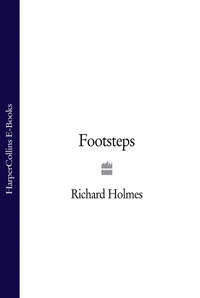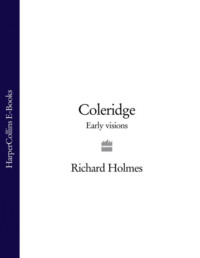
Полная версия
Sidetracks
Almost every spring or summer for thirty years, Gautier made good his escape from Paris, usually in a retrospective flurry of apologies, forwarding addresses, and promises of exotic copy. These flights of the swallow, as they became in one of his most famous poems, ‘Ce que disent les Hirondelles’, were made to Germany, Italy, Spain, North Africa, Egypt, Turkey, even eventually to Russia, and he subsequently published brilliantly coloured imagist accounts of all of them.
Even his apartment, in an italianate hotel particulier at 14 rue Navarin, off the place Pigalle on Montmartre’s lower side, expressed his search for spiritual displacement. Indeed, it was almost a caricature of French Romantic aspirations, furnished as it was with Turkish carpets, Siamese cats, and Italian theatrical ladies, and perfumed with Spanish cooking, Cuban cigars and Algerian hashish. There was, finally, to be an English element, but that was to prove part of the more intimate moeurs.
Moreover, Gautier was acutely conscious of the curiously modern desperation, almost the death-wish, implicit in this passionate longing for other shores, other climes, the other itself. Many of his springtime feuilletons each year played upon this theme with deliberate irony, heralding the age of mass tourism in a distinctly minor key:
‘Nowadays the dream of the masses is – Speed. By iron or steam they seek to conquer that “ancient weight upon all things suspended”. It would seem that their sole concern is to devour Space. Do they do 12 or 15 leagues an hour simply to flee from ennui? If so, the enemy awaits them at the farther platform. Yet how strange is this wild urge for rapid locomotion, seizing people of all nations at the same instant. “The dead go swiftly”, says the ballad. Are we dead then? Or could this be some presentiment of the approaching doom of our planet, possessing us to multiply the means of communication so we may travel over its entire surface in the little time left to us?’ It feels odd to read this paragraph on the faint, blue microfilms for La Presse of 1843.
Yet Gautier’s journeys to London, while part of this lifelong centrifugal urge, seem to have been of a different order. His notes have remained scattered through a score of essays, letters, articles, poems and reviews. London was less a place to visit, than a state of mind to ponder upon. It was a dark mirror, a smoky crystal ball. You could turn it in your hand. Gautier remained profoundly uninterested in its institutions, its monuments, even its literary associations. Rather, it was its atmosphere, its tone, its iridescent qualities, its curious undercurrent of black comedy, which continually drew him back.
On his second visit he summoned an English barber to his rooms at the Hotel Sablonniere, in Leicester Square. His ballet La Péri, with his untouchable amour Carlotta Grisi dancing the title role, was playing at the Theatre Royal, Drury Lane. He was due at the Lord Mayor’s procession and banquet. He needed a shave. The barber knocked, entered, bowed: a thin man with the English whiteness of jowl, dressed entirely in black. In complete silence, with the flowing rapidity of a phantom, he shook out a crisp, white apron, adjusted a chair, and stropped a long razor. Gautier grew increasingly uneasy at each stroke, a victim of those unspeakable suspicions that separate native from foreigner, living from dead.
‘Seeing him so chill, so pale, so mournful, I asked myself if he were not some ill-provisioned resurrectionist who wished to acquire a new subject. At the same time, I instinctively cast my eyes upon that part of the floorboards where my chair rested, anxious to ascertain whether or no there was a hidden trap door through which I should plunge into the cellar bearing a large slit in my throat.’ On the point of calling off the whole operation, Gautier was saved by the inherited logic of Pascal and Voltaire. ‘I made the calming reflexion that, since I was lodged upon the second floor of the hotel, there could hardly be a cellarage beneath my parquet, and that a trap door in opening would make me fall to the first floor, depositing me exactly on top of the pianoforte of an extremely pretty young opera-singer.’ The jolie cantatrice was Ernesta, who subsequently bore Gautier twin daughters. So the English barber was possibly a better Figaro than Gautier concluded at the time.
At Drury Lane, Gautier made extensive notations on the flesh tones of the English girls in the audience. No native painter had ever done justice to their exquisiteness, Gautier felt, except possibly Sir Thomas Lawrence, who could be held ultimately responsible for the creation of the English Rose type, the bloom of a thousand keepsakes, whose torn and treasured leaves were pinned across the dressing-rooms of Europe. A connoisseur of textures, Gautier distinguished sharply between the opulent blonde and the tea-rose blonde, and gazed appreciatively at the complexion of cheek, neck and gorge, which made ‘rice-paper, or the pulpy petal of the magnolia, or the inner pellicle of the egg, or the vellum on which the gothic miniaturists traced their delicate illuminations’ look like coarse cloth by comparison. Yet the genial English passion for decorative gardens, when carried in all its stunning completeness of fruit trees, herbaceous borders and cockle shells, to the top of the English lady’s hat, left him merely stoical.
In the middle of the ballet, Carlotta was required to perform a daring leap in the pas de songe, representing the descent of the péri from the heavenly sphere. It called for the greatest agility and nerve on her part, and perfect timing from her partner Petipa, whose task was to receive her bodily presence on the earth beneath. Occasionally, in Paris, this saute de gazelle had been muffed, and the French audiences, recalled Gautier, had hissed without mercy. At the third performance in London, Carlotta once more misjudged the dangerous jump. As she prepared for another attempt, a ripple ran through the English audience, and murmurs from the stalls were heard begging her not to risk such a frightful plunge a second time. Then a sympathetic voice, from the gods, loudly suggested that it would be better to give Petipa ‘a stiff drink’ first, as he could scarcely ‘stand up on his pins’. Amidst a profound stillness, Carlotta leapt into space, Petipa fielded sinuously, and the house sprang to its feet and gave them three cheers.
But then the English were different in sporting matters. Boats and horses alone really brought out their enthusiasm. There were even moments suggesting lyrical depths, as on the day’s outing at Royal Ascot. Clutching his Oxley’s Authentic Racing Card – which with Robinson Crusoe and the Mansion House menu, was one of the few British texts Gautier ever claimed to have read in the original – he stared round him with calm satisfaction at the scene. There were lawns of ‘vegetable velvet’, ladies with shot-silk dresses and fringed parasols, champagne and Scotch Ale corks flying into the cerulean blue, gypsies dancing round the carriage wheels telling endlessly optimistic fortunes. In the distance, over the undulations of emerald turf, the ‘cherry-red horses ran’. At the far turn, the brightly coloured silks of the jockeys’ caps were ‘like poppies, cornflowers and anemones carried away on the wind’. At the close of each race, the winner stood steaming peacefully in the Royal Enclosure, and a cluster of white pigeons were released into the sky like a shout of purest joy.
It was only later that Gautier learnt that the pigeons simply carried the listings of the betting odds and results to a hundred murky gambling parlours across the nation, which sufficed to transform the occasion into a rather more utilitarian event, ‘a roulette or a Stock Exchange’.
After the mixed triumphs of La Péri, six years elapsed before Gautier next slipped across the Channel. Though his friend’s Tunnel was still inexplicably incomplete, the years of middle age had brought increased travelling comforts. The Chemin de Fer du Nord already ran as far as Rouen, and together with the regular steam packet services, and the celebrated express from Dover, this combined to bring the two capitals within a single day of each other. By the spring of 1849, after nine months of almost continuous political upheavals in Paris, Gautier was already restive for London’s paradoxes and gloomy, introspective charm. His feuilleton of 21 May complained of not being able to take advantage of a newly created package tour, which for 175 francs transported you, housed you, took you on guided tours round the Court, the museums, Richmond, Hampton Court Palace, Greenwich, and even brought you back ‘with all intelligence and care’.
A month later, his column began mysteriously. ‘In this unhappy week of cholera and insurrection which has just gone by, the theatres of Paris have played nothing. The announcement of some major performance would have brought us back in the twinkling of an eye, despite pestilence and politics: for it is on such evil days that Art has need of all its supporters. But the thunder in the street makes the Muses fall silent, and we would have had nothing to do at our post. So we have profited from this sad congé by accomplishing a voyage to China, no less than the intrepid MacCarthy or Monsieur de Langrenée. This voyage cost us two hours and two shillings.’
This unexpectedly exotic expedition turned out to have been a visit by the ferry from Hungerford Bridge to a Chinese junk moored at St Katharine’s Dock. It brought Gautier a new sense of the equivocations of Progress and Empire, almost, very distantly, a sense of menace. Below decks on the junk, he listened distractedly to a Chinese orchestra, with four young men in dark blue silken smocks and pigtails, playing a melancholy composition on drums, gongs, violins and tambourines. Around them the cabin was cluttered with ornate, open-work ivory boxes, porcelain pots and huge grotesque mandrake roots, twisted into fantastical shapes. Gautier meditated on a pile of Chinese coffins in a dark corner, each hewn out of a single log, and painted a glistening vermilion, ‘stacked there, no doubt, for the benefit of the crew in case of cholera or nostalgia’. He was thoughtful. ‘When a concert is finished, one replaces the instrument in its case: when a life is finished, one slips the man into his coffin: and the rest is silence … But why do violins have cases that resemble the bier? Is it because they have souls and voices, and groan like us?’
Returning on deck, under the leaden sky of London, Gautier gazed curiously at a large lacquer cabinet fitted under the poop of the junk which was carved like some gigantic dream-bird. The cabinet formed an open shrine for Buddhist worship, and in it three golden figurines representing the Chinese trinity. In front of them, coloured spills, jossticks and aromatic tapers sent their sweet oriental perfumes drifting heavily over the dark waters of the Thames.
Perhaps, thought Gautier, the traditional piety of the Chinese crew had not been dissolved ‘by contact with the sceptical barbarians …’ He bent down and peered closely at the little, squat buddhas, miniature replicas of the mighty idols he had earlier seen on display at an antiquarian collection in Hyde Park. He studied their impenetrable good humour … ‘but as for the gods themselves, those circumflex eyebrows, those equivocal smiles, and those gross little bellies, all express an attitude towards the worshipper that is ironic, and even irreverent. The devotee does not lack faith; but it seems that the idol itself lacks conviction. Perhaps all religions will come to an end through the agnosticism of their gods.’
It was a foretaste of a sensation he was to have on one of his last visits, in 1851, as he wandered through the imperial splendours of the Great Exhibition at the Crystal Palace. Dazzled by the endless displays of jewelled armaments, exotic plants, stuffed elephants, priceless fabrics, and amorous potions of liquid pearl, he yet remained inexplicably unexalted, doubtful. What he finally remembered was a barred compartment containing several imprisoned Thuggees, the religious stranglers of Durga, the ‘monsterous wife of Shiva, god of destruction’. These men were sullenly engaged in weaving an immense carpet, ‘of evidently European design … with a greyish background spotted with black and red ornaments resembling burns and badly cleaned bloodstains. Its appearance was infinitely sinister and funereal. (Indeed it was as ugly as a home-made English carpet.) What torture it must have been for those poor Thugs, instinctive lovers of beautiful patterns and harmonious colours, to sit weaving this abominable tapestry of expiation!’ This was the picture that stayed in his mind, from all that palace of wonders. This, and the massive pistons and flywheels of the engineering displays.
Yet in the midst of these later trips, with their thickening associations and suggestions, fell a bright shaft. For London unexpectedly and generously provided Gautier with the last great romance of his life, in the elegant shape of a very pretty Italian widow whom he encountered in Bond Street. Marie Mattei had adopted a smart, fast, modern English style, wore charming white waistcoats, rolled her own cigarettes in ‘papelitos’, sucked peppermints and sipped tea, as Gautier fondly recorded in his sonnets. He rapidly made her his mistress, and back in Montmartre she transformed his ‘small red bed with its spiral bedposts’ into a paradise of sexual blue. And there, with a touch of the renowned English coolness in the heat of battle
… quand le plaisir a brisé nos forces,
Nonchalant entr’acte à la volupté,
Nous fumons tous deux en prenant le thé.
But passion, like all things – except perhaps the art that recorded it – was transitory, no permanent gift. As Gautier grew old, and Paris closed round them like a familiar shawl, there came back the memory of the English Sunday, that Feast of Limbo, when shops and pubs and theatres closed, streets were deserted, and everyone seemed to flee the city by boat or coach or charabanc, until it was like a place of the dead, ‘one of those cities peopled by inhabitants who have turned to stone, as Eastern Tales relate’. It haunted him, that vision of melancholy exuding from the very walls, and he wrote wryly: ‘At such times one longed to have a little portable chemist’s outfit, consisting of opium, prussic acid, and acetate of morphine. The thought of suicide is born in the most resolute heart; it is not prudent to fiddle with your pistols or to lean over the balustrades of the bridges … There is but one recourse, to make oneself abominably drunk, to fill one’s stomach with a blazing sunset of rum-punch … but you have to be English for that.’
On those days the only serious British activity seemed to be attending funerals. But the London cemetery, so icy, stark, flowerless and abandoned, with its low graves retaining ‘like mummies, sarcophagi with a vague appearance of the human corpse’ filled him with nothing but lugubrious imaginings, and gave him only an intense desire to remain alive. He turned the dark shape in his hand. But then, finally, was one not a Parisian? He pulled upon a fresh cigar, and stroked the receptive fur of an attendant cat. He thought of the baroque magnificence of the cemetery of Père Lachaise, the swept alleys, the carved chapels, the bright wreaths of blossom. ‘How can the English, a nation so absolutely wedded to “home and comfort”, how can the English resign themselves to being so dreadfully ill at ease in the next world?’
POOR PIERROT
IF YOU ENCOUNTERED PIERROT in Paris today, he would seem innocent enough, quite innocent. Besides, it would probably be in a children’s toyshop. In the Passage Jouffroy, for example, one of those high melancholy ironwork arcades off the boulevard Montmartre, much frequented by Gérard de Nerval in the long autumn days before his suicide, there is a spacious old-fashioned boutique stuffed with cardboard theatres, packs of Petits Metamorphoses, Second Empire dolls’ house furniture, musical boxes that play Chopin – and Pierrots, dozens of them.
There are Pierrot dolls, Pierrot marionettes, Pierrot paperweights, Pierrot glove-puppets, Pierrot mannikins, Pierrot pipe-cleaners, and Pierrot pantins with flat cardboard limbs linked up with string and brass eyelets, and strangely blank on their reverse sides as if their souls had somehow been misplaced. All of them conform religiously to the same uniform: loose white smock and cap, and austerely blanched face that stares back at you with weird intensity. At a distance, perched there in the arcade window, they look like a flock of fantail pigeons in mourning; close to, they are somewhere between clowns and purgatorial spirits.
The childlike symbolism of all this reminds one of those endearingly familiar nursery-rhymes that once announced the terrors and tragedies of popular history, the ‘tishoos of plague, the cherrystones of murder. Pierrot’s origins are mysterious; yet everyone can lament his plight, the gentle distracted ami of the seventeenth-century air, ‘Au clair de la lune’, the creature of laughter and sadness that we vaguely associate with Paris and unrequited love and the bittersweet light of the moon.
But who, in fact, was Pierrot, and why was he so unhappy? That simple question is one of the profound riddles of folk mythology, and the account that follows is merely one episode in what is perhaps an eternally recurring cycle in the human tragi-comedy. It concerns Jean-Gaspard Deburau, one of the legendary giants of the French Romantic theatre, and a figure almost as mysterious as the White Clown whom he rescued from three centuries of despised obscurity in the travelling fairgrounds and anonymous harlequinades of western Europe.
To begin at the beginning is impossible: but one may start with a birth. Deburau was born in Neukolin in 1796 and can correctly be called a Bohemian. The youngest member of a troupe of touring acrobats, he spent a rootless childhood crossing and recrossing a continent convulsed by Napoleonic dreams. Deburau’s father seems to have been an army deserter, a shrewd businessman and a bully; his mother seems to have died young, exhausted by privations; neither had definite nationality. Deburau grew up into a tall, loose-limbed boy, with a long melancholy face, taciturn and withdrawn, a clumsy acrobat and consequently the comic butt of his nimbler brothers and sisters.
There was something dreamy and elusively ambitious about him. A persistent legend tells of a visit to the Sultan’s palace in Constantinople, where the family troupe were commanded to perform in an apparently deserted hall, partitioned off at one end by a diaphanous curtain. For their finale, young Deburau was required to scamper to the top of a human pyramid: as he faltered on to his brother’s shoulders, he was magically rewarded by a glimpse beyond the softly undulating veil. He was looking down on a secret audience, the entire Sultan’s harem, a giddy vision of silks and jewels and curving flesh, forbidden to all mortal eyes on pain of death. He gazed, overbalanced, and fell.
The Deburau family seemed to have settled in Paris towards 1814, but it is not until 1822 that the father’s name first appears on a cast list of the new pantomime theatre, the Funambules. Young Deburau was employed as a buffoon, and revealed a hidden talent for elegant and sometimes savage mimicry. His emotional life remains hidden: the city archives show that at twenty-three he married a flower girl called Adelaide, for whom he bought dresses on credit at the local couturière, so we may perhaps assume that she was beautiful, and that he loved her. But three months later Adelaide died, in a tiny upper lodgings at the Hôtel Bouffiers. A surviving inventory shows a bed with a straw mattress, a round dining table with two flaps, and a chest of drawers with a marble top.
After seven more years of penurious existence, Deburau père died, the family troupe began to disperse, and one has the sense of a tyranny dissolving. For Deburau, then aged thirty, it was a moment of late blossoming. At last he was able to sign his own contract with the Funambules management, and he concluded a solid three-year agreement with a weekly salary of 35 francs, which was about four times what the musicians earned. He was engaged to play one named role only: that of Pierrot, the White Faced Clown. The contract was dated 10 December 1826.
Until this critical moment in theatrical history, the stock part of Pierrot had been minor and ill-defined. Pierrot was loosely evolved from a number of auxiliary clown figures in the Italian Commedia dell’Arte troupes of the sixteenth and seventeenth centuries. He was a figure of fun, rather than of distinction. Experts are inclined to disagree, but Pierrot’s ancestors have been variously identified with Pedrolino, the honest valet of Flaminio Scala’s plays; the wise peasant Bertoldo whose struggles with the Prince of Bologna were first written down by Giulio Croce in the 1570s; the all-purpose buffoon of the fairground show, Il Pagliaccio (Le Paillasse, Old Strawbags); the Giglio or Gilles of the Neapolitan commedia; and the French Fool Gros-Guillaume (Fat Willy) who played in front of Cardinal Richelieu with a face plastered with baker’s flour and two belts to restrain the catholicity of his belly, one above and one below.
Indeed, the ‘poor Pierrot’ whom Deburau inherited was so rich in ancestry that he was in effect perfectly illegitimate, a restless wanderer who sought his name in every city, a mongrel of the booths, a changeling outcast from the dignified family hierarchies of the traditional Commedia. He was quite simply the White Faced Clown, the enfariné, the Fool whose face is blanched – not with paint or wax – but with the homely naïveté of flour and water. In this single recurrent detail lies the probable foundation of his dramatic character and his earliest symbolism. The Clown with the face of flour seems to represent both servile bumpkin stupidity, and its opposite, an eternal peasant wisdom; he also stands for something of the natural fertility of the earth, as persistent and universal as wheat, from which comes both his greed and his amorousness (consider the appetites of Chaucer’s Miller). These traits give Pierrot’s most primitive psychology. It is essentially innocent.
By the eighteenth century the White-Faced Clown had established himself in supporting roles in many of the harlequinades in France, though the Italian Commedia itself had been banished from Paris in 1697 to protect the drama of Molière. The White Clown was a buffoon, valet, trickster and the eternally unsuccessful rival of Arlequin for the love of Columbine; and it is as ‘Gilles’ that he appears in the famous portrait by Watteau of 1721, executed in eight days as a billboard for the Théâtre de la Foire in Paris.
In a curious way, this painting is a premonition of Deburau. The White Clown stands forth in the parade, his limp arms dangling down his white casaque, his feet turned outwards, a proverb of naïveté. Yet he has become suddenly mysterious. Perhaps this is simply because it is one of Watteau’s very last works, with a consumptive glow of loss and transfiguration about it. But perhaps also, it is because Pierrot is suddenly without his mask of flour. From the ageless anonymity of the White Clown, a completely individual face now looks out, enigmatically, with a faint smile of greeting or mockery, the rims of the eyes and the nostrils slightly swollen and red, as if he had been weeping for some reason yet to be revealed. All this is of course a hundred years before Deburau himself stood forward to be judged.
It began (or began again) with a summer newspaper article by Charles Nodier in the Pandora of 1828, heralding with a certain donnish humour the great new Gilles or Pierrot at the Funambules Theatre, a ‘Satan naïf et bouffon’, who needed nothing but a large bank account and a smart carriage to give him a Parisian vogue. Nodier rented a box for a year, and wrote a pantomime especially for Deburau, called appropriately enough Le Songe d’or, a dream of riches.









